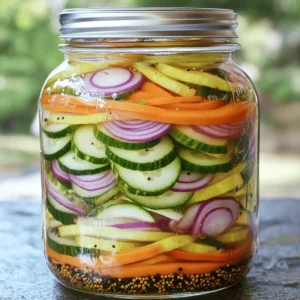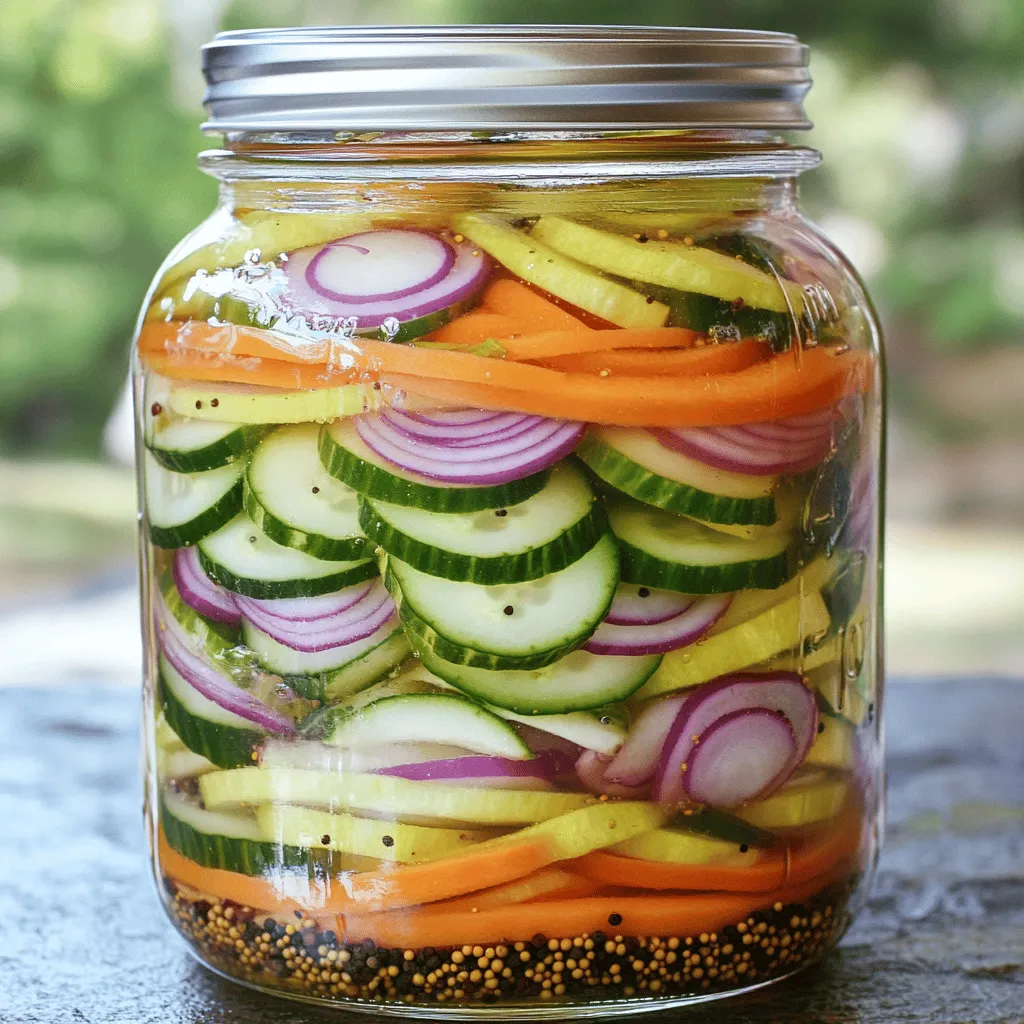Are you ready to add a burst of flavor to your meals? My easy recipe for quick pickled vegetables will do just that! With simple ingredients and a few easy steps, you can transform everyday veggies into zesty delights. Perfect for topping salads or snacking, these pickles bring freshness to any dish. Let’s dive into the world of vibrant, crunchy pickled vegetables that will brighten up your plate!
Ingredients
List of Required Ingredients
– 1 cup cucumber, sliced into thin rounds
– 1 cup carrots, julienned
– 1 cup radishes, sliced thin
– 1 cup red onion, thinly sliced
– 1 cup apple cider vinegar
– 1 cup water
– 2 tablespoons granulated sugar
– 1 tablespoon kosher salt
– 1 teaspoon black peppercorns
– 1 teaspoon mustard seeds
– 1 teaspoon red pepper flakes (optional)
Gather these ingredients before you start. Fresh vegetables give the best taste. The apple cider vinegar adds a nice zing. Sugar and salt balance the flavors well. Black peppercorns and mustard seeds give a warm spice. If you like heat, add red pepper flakes. Using a mix of colors makes the dish pretty too. You can find these items at any grocery store. This recipe is quick and easy. It makes a great snack or side dish. You’ll love how fresh they taste! For the full recipe, check out the steps I provided earlier.
Step-by-Step Instructions
Preparing the Pickling Brine
– Combine apple cider vinegar, water, sugar, salt, peppercorns, mustard seeds, and red pepper flakes in a saucepan.
– Heat over medium, stirring until dissolved.
To start, I mix my brine in a saucepan. I use one cup of apple cider vinegar and one cup of water. Then, I add two tablespoons of sugar and one tablespoon of salt. I like to toss in one teaspoon of black peppercorns and mustard seeds. If you enjoy some heat, add a teaspoon of red pepper flakes. I place the saucepan on medium heat and stir the mix until the sugar and salt dissolve.
Cooling and Layering the Vegetables
– Remove brine from heat and let it cool for 5 minutes.
– Layer the prepared vegetables in a glass jar or bowl.
After the brine simmers and smells great, I take it off the heat. I let it cool for about five minutes. While it cools, I prepare my veggies. I slice cucumbers, julienne carrots, and thinly slice radishes and red onions. I layer them in a glass jar. I like to mix the colors for a pretty look.
Pickling Process
– Pour cooled brine over vegetables.
– Seal and let sit for at least 30 minutes, or refrigerate for stronger flavor.
Now, I carefully pour the cooled brine over the vegetables. I make sure all the veggies are covered in the liquid. If needed, I use a spoon to press them down. Then, I seal the jar or cover the bowl. I let them sit at room temperature for at least 30 minutes. For a stronger flavor, I pop them in the fridge for a few hours or overnight.
These quick pickled vegetables are easy to make. You can enjoy them soon after. For the full recipe, check out the section above.
Tips & Tricks
Perfecting Your Pickles
– Use fresh, crisp vegetables for the best texture.
– Adjust sugar and salt for your taste. A little more sugar gives sweetness. A bit more salt adds flavor.
Enhancing Flavor
– Add herbs like dill or thyme for extra flavor. These herbs give depth.
– Experiment with different types of vinegar. Try rice vinegar for a milder taste or malt vinegar for a stronger kick.
Serving Suggestions
– You can add pickled vegetables to salads, sandwiches, or bowls. They add a nice crunch.
– Pair them with grilled meats or tacos for a zesty touch. They brighten up any meal.
When you make quick pickled vegetables, you can follow the Full Recipe for a tasty result!

Variations
Different Vegetable Combinations
You can mix and match your favorite veggies. Try using bell peppers, zucchini, or asparagus. Each vegetable has its own unique taste. Mixing colors makes your dish look great. The more colorful your jar, the more fun it is to eat!
Alternative Brine Recipes
Vary the brine for new flavors. You can use rice vinegar or malt vinegar for a different taste. Want a little more zing? Add garlic or ginger to your brine. This gives your pickles a nice kick that can surprise your taste buds.
Spicy and Tangy Options
If you love heat, add more red pepper flakes. This will make your pickles spicy and exciting. You can also squeeze in some lime juice for a citrus twist. This adds a bright flavor that makes your pickles even better.
Storage Info
Refrigeration Tips
Store your pickled vegetables in an airtight container in the fridge. This keeps them fresh and crisp. Try to enjoy them within 1-2 weeks for the best taste.
Long-term Storage
If you want to keep them longer, think about using water bath canning methods. This helps preserve the veggies for months. Always label your jars with dates. This way, you can track how fresh they are.
Usage After Shelf Life
If you notice any signs of spoilage, like a bad smell or mold, toss them out. Safety first! Enjoy your quick pickled vegetables in salads, sandwiches, or as a side. For the full recipe, check out the earlier section.
FAQs
How long do quick pickled vegetables last?
Quick pickled vegetables last about 1-2 weeks in the fridge. The vinegar helps preserve them. After this time, their taste and crunch may fade. Always check them for quality before eating.
Can I reuse the pickling brine?
Yes, you can reuse the pickling brine. However, it works best for quick pickling other vegetables. The brine will still have flavor, but it may be less strong. Fresh brine will give you the best results.
What can I make with quick pickled vegetables?
You can use quick pickled vegetables in many ways. They make great garnishes for tacos or sandwiches. You can toss them into salads for extra crunch. They also work well as side dishes for grilled meats.
Are quick pickled vegetables safe to eat?
Yes, quick pickled vegetables are safe to eat. Just make sure you store them properly. Consume them within the suggested time frame for the best taste and safety.
You learned how to make quick pickled vegetables in this blog post. We covered the ingredients, step-by-step instructions, and useful tips. Remember to choose fresh veggies and vary your brine for unique flavors. You can enjoy these pickles in many dishes or as snacks. Keep them in the fridge for a couple of weeks, and don’t forget to check for spoilage. Now, it’s time to experiment and find your own favorite combinations. Happy pickling!

